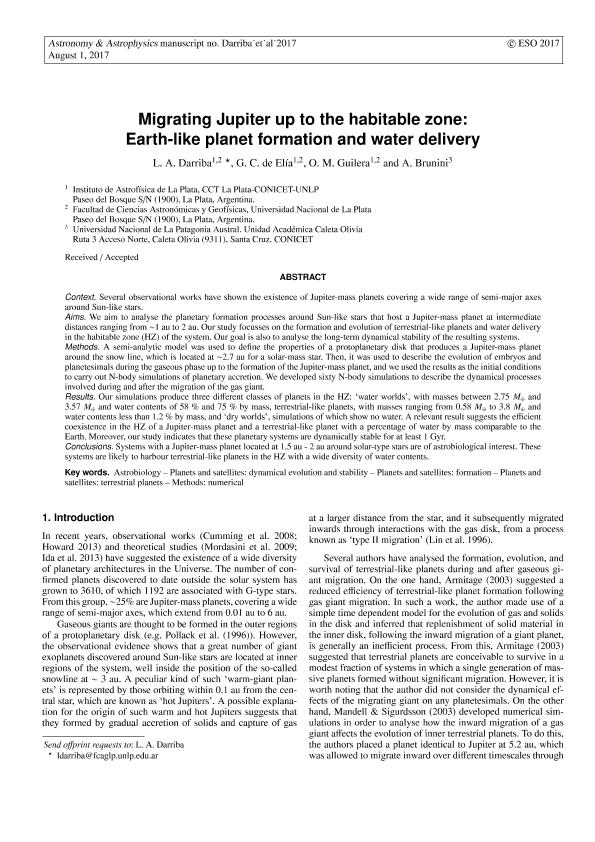Mostrar el registro sencillo del ítem
dc.contributor.author
Darriba, Luciano Ariel

dc.contributor.author
de Elia, G.
dc.contributor.author
Guilera, Octavio Miguel

dc.contributor.author
Brunini, Adrian

dc.date.available
2018-04-06T14:24:57Z
dc.date.issued
2017-08
dc.identifier.citation
Darriba, Luciano Ariel; de Elia, G.; Guilera, Octavio Miguel; Brunini, Adrian; Migrating Jupiter up to the habitable zone: Earth-like planet formation and water delivery; EDP Sciences; Astronomy and Astrophysics; 607; 8-2017; A63
dc.identifier.issn
0004-6361
dc.identifier.uri
http://hdl.handle.net/11336/41071
dc.description.abstract
Context. Several observational works have shown the existence of Jupiter-mass planets covering a wide range of semi-major axes around Sun-like stars. Aims. We aim to analyse the planetary formation processes around Sun-like stars that host a Jupiter-mass planet at intermediate distances ranging from ~1 au to 2 au. Our study focusses on the formation and evolution of terrestrial-like planets and water delivery in the habitable zone (HZ) of the system. Our goal is also to analyse the long-term dynamical stability of the resulting systems. Methods. A semi-analytic model was used to define the properties of a protoplanetary disk that produces a Jupiter-mass planet around the snow line, which is located at ~2.7 au for a solar-mass star. Then, it was used to describe the evolution of embryos and planetesimals during the gaseous phase up to the formation of the Jupiter-mass planet, and we used the results as the initial conditions to carry out N-body simulations of planetary accretion. We developed sixty N-body simulations to describe the dynamical processes involved during and after the migration of the gas giant. Results. Our simulations produce three different classes of planets in the HZ: “water worlds”, with masses between 2.75 M⊕ and 3.57 M⊕ and water contents of 58% and 75% by mass, terrestrial-like planets, with masses ranging from 0.58 M⊕ to 3.8 M⊕ and water contents less than 1.2% by mass, and “dry worlds”, simulations of which show no water. A relevant result suggests the efficient coexistence in the HZ of a Jupiter-mass planet and a terrestrial-like planet with a percentage of water by mass comparable to the Earth. Moreover, our study indicates that these planetary systems are dynamically stable for at least 1 Gyr. Conclusions. Systems with a Jupiter-mass planet located at 1.5−2 au around solar-type stars are of astrobiological interest. These systems are likely to harbour terrestrial-like planets in the HZ with a wide diversity of water contents.
dc.format
application/pdf
dc.language.iso
eng
dc.publisher
EDP Sciences

dc.rights
info:eu-repo/semantics/openAccess
dc.rights.uri
https://creativecommons.org/licenses/by-nc-sa/2.5/ar/
dc.subject
Astrobiology
dc.subject
Planets
dc.subject
Formation of Planets
dc.subject
Terrestrial Planets
dc.subject
Numerical Methods
dc.subject
Dynamical Evolution
dc.subject
Stability
dc.subject.classification
Astronomía

dc.subject.classification
Ciencias Físicas

dc.subject.classification
CIENCIAS NATURALES Y EXACTAS

dc.title
Migrating Jupiter up to the habitable zone: Earth-like planet formation and water delivery
dc.type
info:eu-repo/semantics/article
dc.type
info:ar-repo/semantics/artículo
dc.type
info:eu-repo/semantics/publishedVersion
dc.date.updated
2018-03-26T14:39:17Z
dc.journal.volume
607
dc.journal.pagination
A63
dc.journal.pais
Francia

dc.journal.ciudad
Paris
dc.description.fil
Fil: Darriba, Luciano Ariel. Consejo Nacional de Investigaciones Científicas y Técnicas. Centro Científico Tecnológico Conicet - La Plata. Instituto de Astrofísica La Plata. Universidad Nacional de La Plata. Facultad de Ciencias Astronómicas y Geofísicas. Instituto de Astrofísica La Plata; Argentina. Universidad Nacional de La Plata. Facultad de Ciencias Astronómicas y Geofísicas; Argentina
dc.description.fil
Fil: de Elia, G.. Consejo Nacional de Investigaciones Científicas y Técnicas. Centro Científico Tecnológico Conicet - La Plata. Instituto de Astrofísica La Plata. Universidad Nacional de La Plata. Facultad de Ciencias Astronómicas y Geofísicas. Instituto de Astrofísica La Plata; Argentina. Universidad Nacional de La Plata. Facultad de Ciencias Astronómicas y Geofísicas; Argentina
dc.description.fil
Fil: Guilera, Octavio Miguel. Consejo Nacional de Investigaciones Científicas y Técnicas. Centro Científico Tecnológico Conicet - La Plata. Instituto de Astrofísica La Plata. Universidad Nacional de La Plata. Facultad de Ciencias Astronómicas y Geofísicas. Instituto de Astrofísica La Plata; Argentina. Universidad Nacional de La Plata. Facultad de Ciencias Astronómicas y Geofísicas; Argentina
dc.description.fil
Fil: Brunini, Adrian. Universidad Nacional de la Patagonia Austral. Unidad Academica Caleta Olivia; Argentina
dc.journal.title
Astronomy and Astrophysics

dc.relation.alternativeid
info:eu-repo/semantics/altIdentifier/url/http://www.aanda.org/10.1051/0004-6361/201630185
dc.relation.alternativeid
info:eu-repo/semantics/altIdentifier/doi/http://dx.doi.org/10.1051/0004-6361/201630185
Archivos asociados
